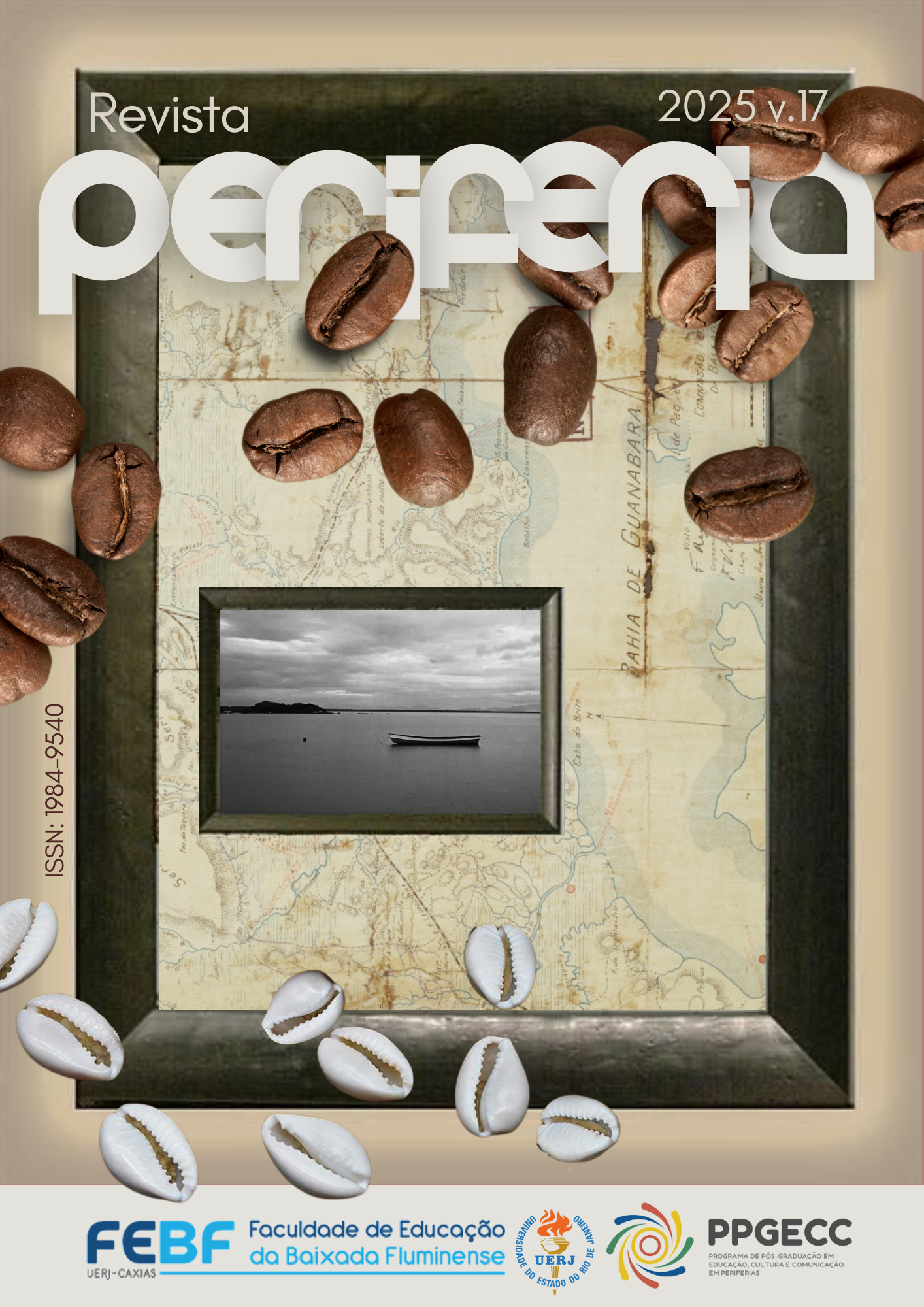“A DIFERENÇA EXISTE E MORA AQUI”:
Movimentações sobre currículos indígenas e BNCC no Estado do Amazonas - Brasil
DOI:
https://doi.org/10.12957/periferia.2025.86325Palavras-chave:
Educação Escolar Indígena; , Currículo; , BNCC; , Currículos Indígenas.Resumo
Neste artigo, temos como objetivo questionar: É possível pensar a ideia do comum a todos quando se trata de populações indígenas? Essa problematização parte do questionamento de uma política educacional que se pretende para todos habitantes do território nacional, escolhendo e regulando os conhecimentos que julgam essenciais, desde a Educação Infantil até o Ensino Médio, ocasiona a tentativa de fixação de identidade – apresentado por meio de um indígena que pertence à nação brasileira – no qual a política curricular aspira dar conta do trajeto educacional de forma indistinta. Para discutir essas questões será realizado a análise de duas cenas particulares: as movimentações trazidas na discussão de uma Matriz Curricular Indígena de Referência para o Estado do Amazonas e as discussões sobre a Base Nacional Comum Curricular (BNCC) realizada pelo Fórum de Educação Escolar e Saúde Indígena do Amazonas (FOREEIA). As discussões rasuram a ideia de reconhecimento das singularidades trazidas pela BNCC que, ao tentar gerar homogeneidade por meio da ideia de ‘comum a todos’ e ao tecer a existência de um indígena que apreende conteúdos, regulados pelo ambiente escolar, torna o espaço de diálogo com a diferença cada vez mais restrito. Rasurando essa ideia, apresenta-se a concepção de currículo como campo de produção cultural, onde a (im)possibilidade de uma política curricular ‘abarcar’ todos não existe, uma vez que as sociedades indígenas possuem suas múltiplas singularidades
Referências
APPADURAI, Arjun. Dimensões Culturais da Globalização. Tradução de Telma Costa. Editora Teorema, Lisboa, Portugal, 2004.
ANDERSON, Benedict. Comunidades imaginadas: reflexões sobre a origem e a difusão do nacionalismo. São Paulo: Companhia das Letras, 2008.
BANIWA, Gersen. BNCC e a diversidade indígena: desafios e possibilidades. In: SIQUEIRA, Ivan Cláudio Pereira. BNCC: educação infantil e ensino fundamental. BNCC: educação infantil e ensino fundamental / organização Ivan Cláudio Pereira Siqueira. — São Paulo: Fundação Santillana, 2019. p.38-55.
BHABHA, Homi. O local da Cultura. 2 ed. Belo Horizonte: Editora UFMG, 2007.
BRASIL, População indígena das grandes regiões (Norte). Instituto Brasileiro de Geografia e Estatística (IBGE). Brasília, DF: IBGE, 2022.
DERRIDA, Jacques. Torres de Babel. Belo Horizonte: Editora UFMG, 2002.
DERRIDA, Jacques, ROUDINESCO, Elisabeth. De que amanhã... diálogo. Rio de Janeiro: J. Zahar, 2004.
INSTITUTO SOCIOAMBIENTAL (ISA). Disponível em: https://terrasindigenas.org.br/pt-br/terras-indigenas/3895#demografia. Acesso no dia 15/09/2020.
LOPES, Alice Casimiro. Ainda é possível um currículo político? In: LOPES, Alice Casimiro; DE ALBA, A. Diálogos curriculares entre Brasil e México. Rio de Janeiro: EdUERJ, 2014.(43-62)
LOPES, Alice Casimiro. Apostando na produção contextual do currículo. In: AGUIAR, Márcia Angela da S.; DOURADO, Luiz Fernando. A BNCC na contramão do PNE 2014-2024: avaliação e perspectivas. Organização: Márcia Angela da S. Aguiar e Luiz Fernandes Dourado (org.). [Livro Eletrônico]. – Recife: ANPAE, 2018. (p. 23-27)
LOPES, Alice Casimiro; MACEDO, Elizabeth. Teorias do currículo. São Paulo: Cortez, 2011.
MACEDO, Elizabeth. Currículo como espaço-tempo de fronteira cultural. Revista Brasileira de Educação, v. 11 n. 32 maio/ago. 2006. p. 285-272.
MACEDO, Elizabeth. Currículo, identidade e diferença: articulações em torno das novas diretrizes curriculares nacionais para a educação básica. Projeto de Pesquisa apresentado ao CNPq. (Disponível em www. currículo-uerj. pro. br), 2011.
MACEDO, Elizabeth. Currículo e conhecimento: aproximações entre educação e ensino. Cadernos de Pesquisa, v.42 n.147 p.716-737 set./dez. 2012.
MACEDO, Elisabeth. Currículo, cultura e diferença. In: LOPES, Alice C. e DE ALBA. A. Diálogos curriculares entre Brasil e México. Rio de Janeiro: Ed. EdUERJ, 2014a. (p.83-123)
MACEDO, Elizabeth. Currículo, Identidade e Diferença: Articulações em torno das DCN para o Ensino Fundamental. Relatório de Projeto de Pesquisa. Universidade do Estado do Rio De Janeiro, 2014b
MACEDO, Elizabeth. Mas a escola não tem que ensinar?: Conhecimento, reconhecimento e alteridade na teoria do currículo. Currículo sem Fronteiras, v. 17, n.3, set./dez. 2017, p. 539-554.
MACEDO, Elisabeth. “A base é a base”. E o currículo que é? In: AGUIAR, Márcia Angela da S.; DOURADO, Luiz Fernando. A BNCC na contramão do PNE 2014-2024: avaliação e perspectivas. Organização: Márcia Angela da S. Aguiar e Luiz Fernandes Dourado (org.). [Livro Eletrônico]. – Recife: ANPAE, 2018. (p. 28-33)
RIBEIRO, William de Goes. Currículo, subjetivação e política da diferença: um diálogo com Homi Bhabha* Conjectura: Filos. Educ., Caxias do Sul, v. 22, n. 3, set./dez. 2017. (p. 576-597)
SEDUC. Matriz Curricular Intercultural de Referência para o Ensino Fundamental
de 1º ao 9º ano e Ensino Médio para as Escolas Indígenas do Estado do Amazonas - Resolução nº 02/2014 – CEEI-AM, Manaus: Amazonas, 2014.
TASSINARI, Antonella Maria Imperatriz. Escola indígena: novos horizontes teóricos, novas fronteiras de educação. In: SILVA, Aracy Lopes da; FERREIRA, Mariana Kawall Leal (Org.). Antropologia, história e educação: a questão indígena e a escola. 2. ed. São Paulo: Global, 2001. p. 44-70
VIEIRA, Alva Rosa Lana. Políticas dos territórios Etnoeducacionais no Amazonas: perspectivas para efetivação da educação escolar indígena, 2023. Tese (Doutorado em educação). Faculdade de Educação Programa de Pós-Graduação em Educação, Manaus, 2023.
Downloads
Publicado
Como Citar
Edição
Seção
Licença
Autores que publicam nesta revista concordam com os seguintes termos:- Autores mantém os direitos autorais e concedem à revista o direito de primeira publicação, com o trabalho simultaneamente licenciado sob a Creative Commons Attribution License que permitindo o compartilhamento do trabalho com reconhecimento da autoria do trabalho e publicação inicial nesta revista.
- Autores têm autorização para assumir contratos adicionais separadamente, para distribuição não-exclusiva da versão do trabalho publicada nesta revista (ex.: publicar em repositório institucional ou como capítulo de livro), com reconhecimento de autoria e publicação inicial nesta revista.
- Autores têm permissão e são estimulados a publicar e distribuir seu trabalho online (ex.: em repositórios institucionais ou na sua página pessoal) a qualquer ponto antes ou durante o processo editorial, já que isso pode gerar alterações produtivas, bem como aumentar o impacto e a citação do trabalho publicado (Veja O Efeito do Acesso Livre).







